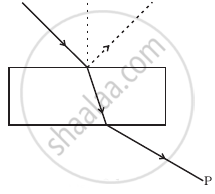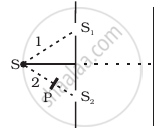Advertisements
Advertisements
प्रश्न
For a glass plate as a polariser with refractive index 1.633, calculate the angle of incidence at which light is polarised.
उत्तर
M = 1.633
∵ M = tanip
∴ip = tan-1M
= tan-1(1.633)
= 58°311
APPEARS IN
संबंधित प्रश्न
What is a Polaroid?
If the critical angle of a medium is sin-1(3/5), find the polarising angle.
What dose a polaroid consist of?
How does one demonstrate, using a suitable diagram, that unpolarised light when passed through a Polaroid gets polarised?
Show, with the help of a diagram, how unpolarised sunlight gets polarised due to scattering.
Two polaroids P1 and P2 are placed with their pass axes perpendicular to each other. An unpolarised light of intensity Io is incident on P1. A third polaroid P3 is kept in between P1 and P2 such that its pass axis makes an angle of 45° with that of P1. Determine the intensity of light transmitted through P1, P2 and P3
Unpolarised light is passed through a polaroid P1. When this polarised beam passes through another polaroid P2 and if the pass axis of P2 makes angle θ with the pass axis of P1, then write the expression for the polarised beam passing through P2. Draw a plot showing the variation of intensity when θ varies from 0 to 2π.
State two uses of Polaroid.
The glass plate of refractive index 1.732 is to be used as a polarizer, its polarising angle is _______.
Show using a proper diagram how unpolarised light can be linearly polarised by reflection from a transparent glass surface.
A ray of light is incident on a transparent medium at a polarizing angle. What is the angle between the reflected ray and the refracted ray?
What is the difference between polarised light and unpolarised light?
A ray of ordinary light is travelling in air. It is incident on air glass pair at a polarising angle of 56°. Find the angle of refraction in glass.
Light transmitted by Nicol prism is ______.
The transverse nature of light is shown in ______.
Discuss polarisation by selective absorption.
What is partially polarised light?
List the uses of polaroids.
State Brewster’s law.
Discuss about pile of plates.
Mention the types of optically active crystals with example.
What is normal focusing?
An unpolarised light of intensity 32 Wm-2 passes through three Polaroids such that the axes of the first and the last Polaroids are at 90°. What is the angle between the axes of the first and middle Polaroids so that the emerging light has an intensity of only 3 Wm-2?
The reflected light is found to be plane polarised when an unpolarized light falls on a denser medium at 60° with the normal. Find the angle of refraction and critical angle of incidence for total internal reflection in the denser to rarer medium reflection.
A plane mirror produces a magnification of
Consider a light beam incident from air to a glass slab at Brewster’s angle as shown in figure. A polaroid is placed in the path of the emergent ray at point P and rotated about an axis passing through the centre and perpendicular to the plane of the polaroid.

For the same objective, find the ratio of the least separation between two points to be distinguished by a microscope for light of 5000 Å and electrons accelerated through 100 V used as the illuminating substance.
Figure shown a two slit arrangement with a source which emits unpolarised light. P is a polariser with axis whose direction is not given. If I0 is the intensity of the principal maxima when no polariser is present, calculate in the present case, the intensity of the principal maxima as well as of the first minima.

A polarizer - analyser set is adjusted such that the intensity of light coming out of the analyser is just 10% of the original intensity. Assuming that the polarizer - analyser set does not absorb any light, the angle by which the analyser need to be rotated further to reduce the output intensity to be zero, is ______.
